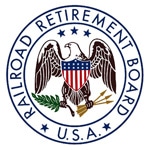

The adjusted reduction amount is based on revised projections of benefit claims and payments under the Railroad Unemployment Insurance Act. It will remain in effect through September 30, 2016, the end of the fiscal year. Reductions in future fiscal years, should they occur, will be calculated based on applicable law.
The daily benefit rate is $72, so the 6.8 percent reduction in railroad unemployment and sickness benefits will reduce the maximum amount payable in a two-week period with 10 days of unemployment from $720.00 to $671.04.
Certain railroad sickness benefits are also subject to regular tier I railroad retirement taxes, resulting in a further reduction of 7.65 percent. Applying the 6.8 percent reduction to these sickness benefits will result in a maximum two-week total of $619.71.
These reductions are required under the Budget Control Act of 2011 and a subsequent sequestration order to implement the mandated cuts. The law exempts social security benefits, as well as railroad retirement, survivor and disability benefits paid by the RRB, from sequestration.
When sequestration first took effect in March 2013, railroad unemployment and sickness benefits were subject to a 9.2 percent reduction. Under the law’s requirements, this amount was then adjusted to 7.2 percent in October 2013, and 7.3 percent in October 2014.
In fiscal year 2014, the RRB paid $11.9 billion in retirement and survivor benefits to about 562,000 beneficiaries, and net unemployment-sickness benefits of $84.4 million to nearly 25,000 claimants.
Related News
- New Jersey Train Length, Crew Size Law Awaits Governor’s Signature
- CSX Conductor, Single Mother Devastated in Head-on Collision
- SOFA Safety Alert
- AJFL Scholarship Application Opens Soon
- SMART-TD Applauds FRA and DOT for Strengthening Cross-Border Rail Safety Protections
- Regional Training Seminars coming to St. Paul, Baltimore in 2026
- Transit Funding Boost Proposed by SMART-TD Backed Bill
- California SMART-TD Brother Killed on the Job
- Union Mourns the Loss of Brother Charles Harrison
- FRA Issues Grade-Crossing Safety Advisory